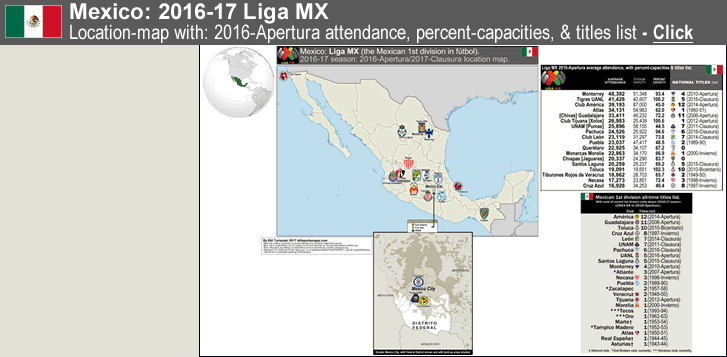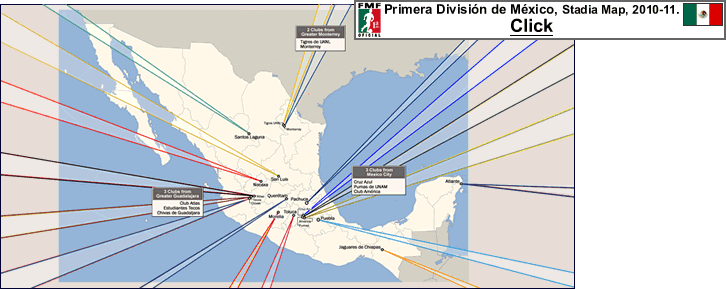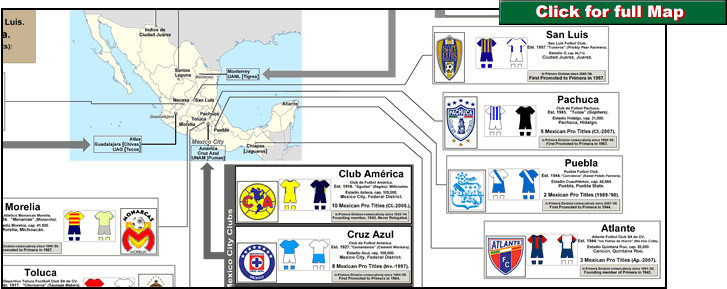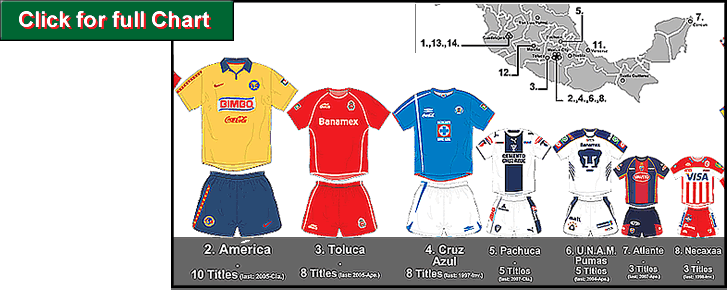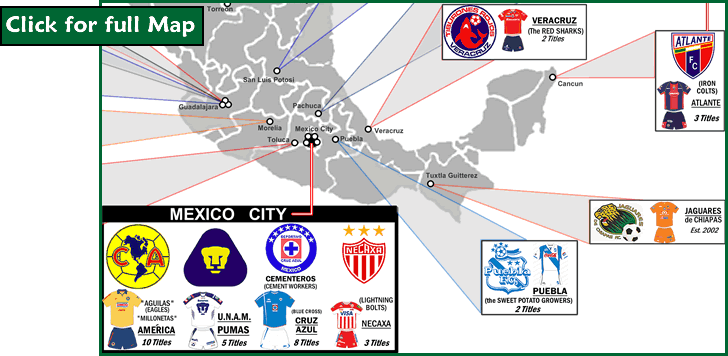Please note: to see my most-recent post on Mexican football (from January 2017), click on the following, category: Mexico/fútbol.
.
.
.
.
.
.
.
.
.
.

2012-13 Liga MX location-map with estimated attendance figures from May 2012, plus Mexican pro fútbol titles list
…
…
From goal.com, from December 30, 2012, ‘Tom Marshall: A 2013 Liga MX wishlist
Eight suggestions to take Liga MX to an even higher level‘.
…
The Mexican first division, which has been called Liga MX since July 2012, began it’s 2013 Clausura tournamnet on the weekend of January 4th through 6th 2013. Reigning champions are the 6-year-old club from Baja California, Club Tijuana. Here is an article about the first weekend of play, ‘Tijuana opens Clausura with a win‘ (AP via msn.foxsports.com).
‘Liga MX – Fixtures, Results, Table‘ (soccerway.com).
…
Note: because there are parts of Mexico (primarily in the north of the country) which have organized (amateur) leagues of American-style gridiron football, to avoid any confusion, the sport I am covering here [which is association football, aka football, aka soccer] will be referred to as fútbol.
…
Professional fútbol began in Mexico in 1943-44
Professional fútbol began in Mexico in 1943-44. There were 9 founding members of the league, which was, until 1950, called Liga Mayor (the Major League) [Then it was called Primera Divisiión up to 2010-11.]. Four of the founding pro clubs from the first season in 1943-44 are currently [2012-13] in the Mexican first division –
Atlante FC, known as los Potros Hierros (the Iron Colts), who were originally from Mexico City, and have been located in far eastern Mexico in Cancún (on the Gulf of Mexico) since 2007;
CD Guadalajara (aka Chivas [the Goats]), who are from Mexico’s second-city Guadalajara;
Club Atlas, who are known as los Zorros (the Foxes), and who also are from Guadalajara; and
Club América, known as las Águilas (the Eagles), or, alterenately as los Millonetas (the Millionaires) – América are from Mexico City, Federal District.
Of those 4 charter members, 2 stand out for their on-field success and for their vast, nation-wide support, and those two of course are Chivas and Club América. Chivas and Club América are the only two clubs in Mexico who have played every one of the 72 seasons (and all 88 tournaments) of top flight Mexican football (and have never been relegated). {see the page at es.wikipedia.org, ‘Liga MX/Equipos_participantes Temporada_2012-2013‘ (sp.wikipedia.org)}.
Those two clubs are also among the 3 most successful, with Chivas Guadalajara boasting the most Mexican pro titles, with 11 (but none since 2006); and Club América tied for second-best (along with Deportivo Toluca) with 10 Mexican pro titles (but none since 2005). Toluca, known as Diablos Rojas (the Red Devils), are from the city of Toluca, which is about 63 km. (39 miles) west of Mexico City. Greater Toluca is the 5th-largest metro-area in Mexico {with a metro population of around 1.6 million/2005 figure}. Toluca won their 10th title in May 2010.
All-time Mexican Professional Fútbol titles list (1943-44 to 2012-Apertura)
Note, click on image below to get the titles list on a separate page…
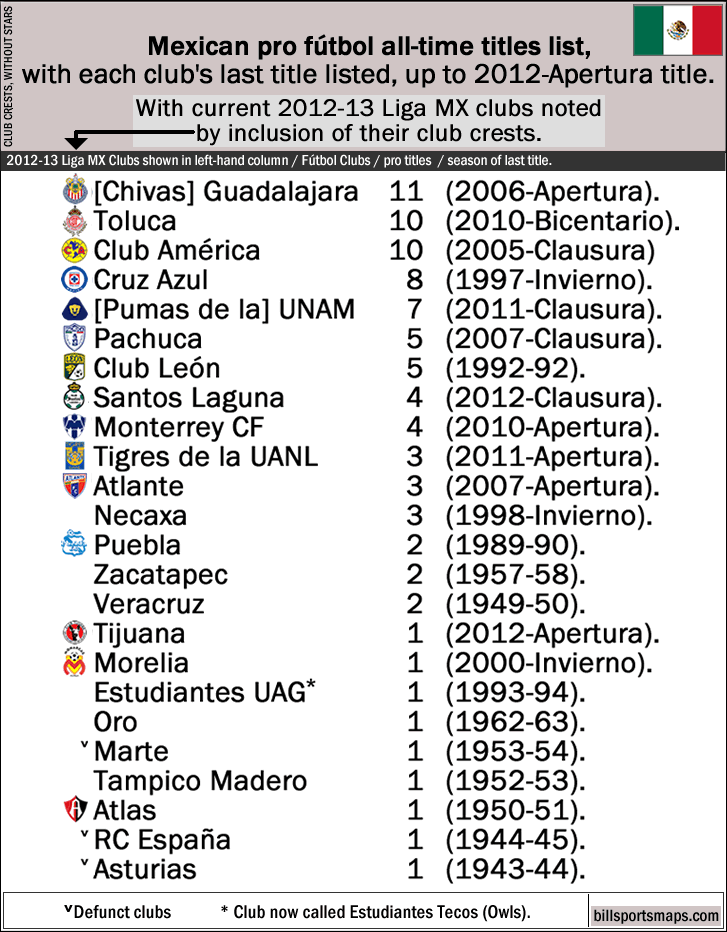
…
If you want to see the full Mexican titles list (with each title listed by date), here is the all-time list of Mexican ‘titles by club‘ (en.wikipedia.org/wiki/Liga_MX#Titles_By_Club).
…
The Map Page, and the elements there…
Location-map
On the map page, there is a location-map of 2012-13 Liga MX. Here are the 2 sites (FootieMap.com and Soccer Mexicana.com) whose maps of 2012-13 Liga MX were very helpful in making my map here –
http://www.footiemap.com/?co=mexico.
http://www.soccerimport.com/soccermexicana.com/files/2012%20Apertura%20Team%20Locations.jpg.
Population-density map of Mexico [which was not drawn by billsportsmaps]
Also on the map page is a population-density map of Mexico (from circa 2006), which is from this page at Wikipedia, ”Metropolitan areas of Mexico‘(en.wikipedia.org [uploaded by Rune.welsh].
The attendance figures at the far right on the map page…
Attendance figures for Mexican fútbol, as a rule, simply do not exist. Why? Corruption, probably. But last season, the Mexican sports news website cancha.com took the initiative and had reporters make estimates of the crowd sizes at all the Mexican Primera División matches. So, via soccer365.com, and originally via the Mexican sports website Cancha.com (sorry, I could not find the original post at cancha.com), here is an article by Tom Marshall about that…’Club America tops attendance league‘ (soccer365.com).
Note, click on image below to get the attendance data on a separate page…

Data in the above graphic is from: http://soccer365.com/news/world_news/the_view_from_mexico/17000/club_america_tops_attendance_league.
…
Mexican league format and format changes
The Mexican top flight is an 18-team league. Since 1996-97, the Mexican first division has had a split season format, within a main 10-month-long season (like in Argentina and other places in South America). So that means there are 2 champions each season. The Apertura (ie, ‘The Opening’) comes first (from August to early December); then the Clausura (ie, ‘The Closing’) is played (from January to May). Teams play 17 games in each half-season, then the top 8 will play from 2 to 6 more matches as they compete in the Liguilla (aka the playoffs) to determine the champion of either the Apertura or the Clausura.
In 2012, the Mexican first division re-branded and became Liga MX ['mx' is a primary Mexican Internet address-suffix]. That followed a long overdue format change in 2011-12, when the league got rid of their arbitrary 3-sub-division league format, where teams, for the first 17 games of each half-season, were divided into three 6-team groups on no basis, geographic or otherwise (except for probable gaming of the system by big clubs). I would describe it in more detail, but what is the point?…it is now gone and good riddance. But the league format still includes the Liguila, which is basically a playoff system with the top 8 teams qualifying. But those bizarre 6-team sub-groups are gone, so the Mexican first division is now a lot easier to follow. And though the Euro-snob football purists might look askance at the playoff-format, well, those well-attended playoffs have saved many a Mexican fútbol club from bankruptcy and liquidation in the last 40 years or so.
Mexican 2nd Division
The second division in Mexico was established in 1950. For the lions’ share of the seasons in Mexican fútbol since 1950-51, there has been a one team promoted/one team releagted system between divisions 1 and 2. Last year, as part of the modern-day re-branding, the Mexican second division was re-named Ascenso MX (Ascenso means Promotion). Ascenso MX has 15 teams. The Mexican second division also did away with the sub-group format in 2011. The Apertura and Clausura champions in Ascenso MX square off for a two-legged finals to determine who is the sole club promoted to the first division. Last season it was 5-time national champions Club León, who have now returned to the Mexican first division after a decade in the second tier. They supplanted the third-biggest club in the Greater Guadalajara area, Estudiantes Tecos (Owls).
Relegation to the 2nd Division
Relegation in the Mexican top flight is as follows – one club is relegated each season, and that is determined by the lowest 3-season total points ratio (ie, just like Argentina’s cynical system). This basically makes it easy for established clubs to avoid a one-bad-season relegation, and makes it harder for just-promoted clubs to remain in the first division, because newly-promoted clubs usually have to finish closer to the middle of the table to avoid the drop, since their points ratio will be from just 34 games versus other clubs whose ratio will be determined from 68 or 102 games. Currently, it looks like Club Atlas and Querétaro will be in a relegation battle during the 2012-Clausura, see this {http://en.wikipedia.org/wiki/2012%E2%80%9313_Liga_MX_season#Relegation}.
The Liguilla
The Liguilla has existed in the Mexican top flight since 1970. Originally, it was just a play-off between the leaders of each of 2 sub-groups, but it has evolved to now comprise the top 8 clubs after each 17-match half-season. The Liguilla part of the league format is similar to the latter stages of the UEFA Champions League in that the teams are seeded (ie, 1st place plays 8th place, etc.) and the teams are placed in a bracket and they play two-legged ties, with the aggregate-score winner advancing (but in Mexico, if the score ends up being tied after both legs are played, the higher seed advances [like in the Italian Serie B promotion playoff]). Unlike the UEFA CL Final but like the Copa Libertadores Finals, the Liga MX Liguilla Finals is a two-match finals.
…
The last 3 Mexican champions (the 2011-Apertura, the 2012-Clausura, and the 2012-Apertura)
2011 Apertura champions – Tigres de UANL
The first club to win the title in the simplified/modified new format was Tigres de UANL, the club from the municipality of San Nicholás de los Garza, which is in the north-central part of Greater Monterrey (Monterrey is the third-largest-city in Mexico, it’s metro area population is around 4.0 million {2010 figure/here) UANL stands for Universidad Autónoma de Nuevo León, which is (obviously) a large university in Monterrey in the State of Nuevo León. [ Note: university-affiliated professional sports teams, which to the American or Canadian might sound like a contradiction, are somewhat widespread in Latin American countries (like in Mexico, Chile, and Peru, to name a few) (I say it might sound like a contradiction to Americans, because college sports athletes in the NCAA in the USA are, shamefully, not allowed to be paid). ]
It was the amber-and-royal-blue clad Tigres’ 3rd Mexican title, and their first championship in 28 and-a-half years. Here’s an article about that from SB Nation, ‘UANL Tigres Vs. Santos Laguna, 2011 Apertura Liguilla Final: Tigres Win 4-1 On Aggregate‘ [from Dec. 11 2011]. Although Tigres do not really have much support outside of Greater Monterrey {see this chart from my last post on Mexican fútbol, here}, they have an impressive local fan base and drew around 41,000 per game last season, which was second only to Club América, and was above 95 percent-capacity. Tigres won the 2011-12 Apertura finals over Santos Laguna by a score of 4-1 aggregate.
Below are photos of Tigres de UANL’s Estadio Universitario.
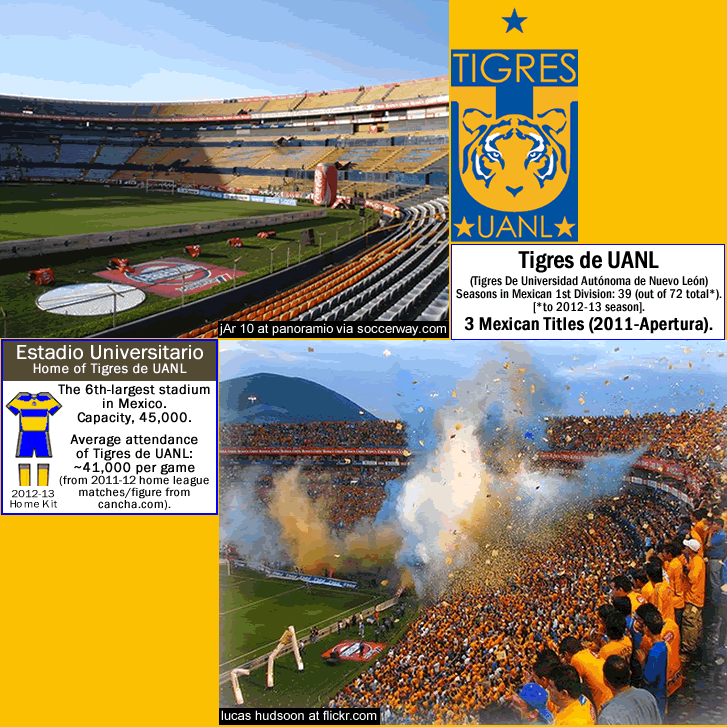
Photo and Image credits above -
jAr 10 at panoramio via soccerway.com.
lucas hudsoon at flickr.com
Tigre 2012-13 home kit from ‘Tigres de UANL‘ (en.wikipedia.org).
…
2012 Clausura champions – Santos Laguna
5 months after coming up just short, the green-and-white-hooped-jersey clad Santos Laguna did one better and won the 2012-Clausura over the other big club from Monterrey, Monterrey CF. To get to the finals, Santos Laguna had to beat reigning champs Tigre in the Semifinals [Tigre being the club that had just defeated them in the 2011-Apertura finals]. And Laguna did that by scoring 2 goals in 3 minutes (in the 86th and 89th minutes) in the 2nd leg. Both those semifinals goals were scored by a local native, the Torreón-born FW Oribe Peralta. Then Santos Laguna beat Monterrey in the finals on May 17th & 20th 2012 by the score of 3-2 aggregate, with Oribe Peralta once again scoring the winning goal (see photos and captions below). Santos Laguna are an up-and-coming club with a swank new stadium from a city in north-central Mexico – Torreón – which is part of a larger metro area called Comarca Lagunera (the 9th largest metro-area in Mexico with a metro-area pop. of around 1.2 million) and which has a solid and diversified economy these days (such as in textile-manufacturing, metal-processing, and in truck-tractor-and-automobile manufacturing). That was Santos Laguna’s 4th Mexican title, all of which have been won since 1996. Santos Laguna had never been in the first division before 1988-89. This is a club that had little history to speak of 30 years ago and now have a bright future. Santos Laguna draw around 25,000 per game in their 30,000-capacity jewel of a stadium (see links below).
From lajornadamichoacan.com.mx, from May 12, 2012, ‘Santos, campeón de México‘.
Here is an article with a nice infographic, from November 11, 2009, by Arturo Black Fonseca, from LaAficion.com, ‘TSM: Estadio Corona, El estadio más avanzado de México‘ [translated, 'TSM (Territorio Santos Modelo): Estadio Corona, The most advanced stadium of Mexico']
Below are photos of Santos Laguna’s Estadio Corona, and photos of the players who scored in the 2012-Apertura Finals 2nd Leg.
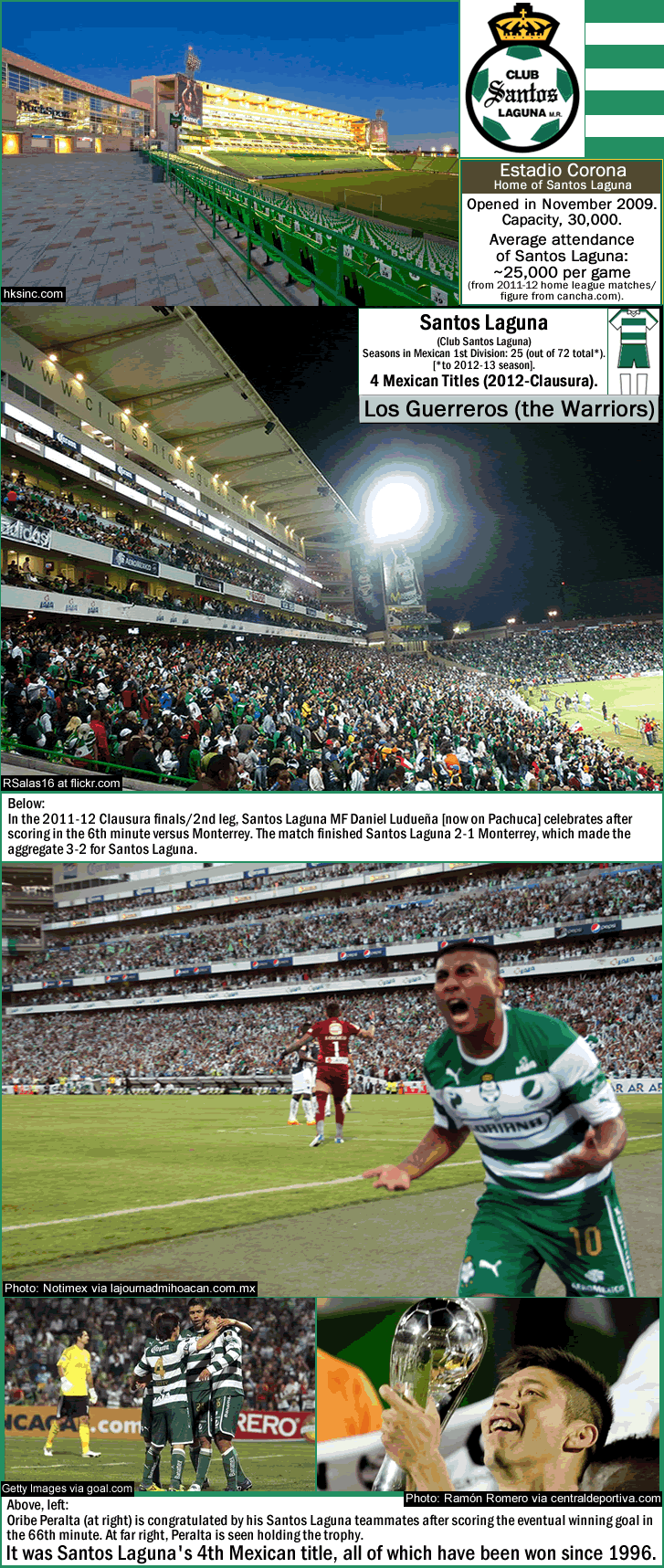
Photo and Image credits above -
hksinc.com.
RSalas16 at flickr.com.
Notimex via lajournadmihoacan.com.mx.
Getty Images via goal.com.
Ramón Romero via centraldeportiva.com
Santos Laguna 2012-13 home kit from ‘Santos Laguna‘ (en.wikipedia.org).
…
2012 Apertura champions – los Xolos de Club Tijuana
Then, very recently, in the 2012 Apertura (which finished on December 2nd, 2012) a virtually brand-new club won their first Mexican title in their 2nd season in the top flight – Club Tijuana, who are nicknamed Xolos. Xolos is the common name for the Mexican Hairless Dog {‘Mexican Hairless Dog‘ (en.wikipedia.org)]. The full name of this very ancient breed of dog is Xoloitzcuintli (it was the dog of the Aztecs/ it fell out of favor/ Mexican artists Diego Rivera and Frida Kahlo revived interest in them by placing them in many of their paintings). So, how do you pronounce it? If you are an Anglo, don’t even try, just say ‘Sho-lo’. But if you want to try, or if you just want more info on this fascinating breed of dog, see this nice video, ‘Dogs 101 – Xoloitzcuintli‘ (youtube.com [4:43 video uploaded by MultiKennel2010]). OK, back to fútbol…
In late November 2012, led by their Argentine-born ethnic Syrian/Lebanese manager Antonio ‘El Turco’ Mohammed, Club Tijuana advanced to the Finals despite being down 2-0 in the semifinals 1st leg versus Club León and left for dead. But in the 2nd leg, at Xolos’ home ground – the nascent cauldron known as Estadio Caliente – Club Tijuana beat Leon 3-0 to claim the semifinal series with a 3-2 aggregate. Xolos then went on to face top-seeded Toluca, which had eliminated Club America in the other semifinals match-up. It was a tight affair in the frenetic 1st leg in Tijuana, with Xolos taking a 2-1 lead. Here are video highlights of that 1st leg Finals match on Nov. 29 2012 in Tijuana -
video, ‘Xolos de Tijuana vs Toluca 2-1 Final Apertura 2012 [1st leg]...’ (youtube.com [4:36 video uploaded by EL VERGON SANTOS]).
But Toluca didn’t really show up for the 2nd leg despite the home field advantage, with Xolos coming out the gate in force and in their customary attack-minded mode, and never leaving much of a doubt who would prevail. In the end, Tijuana handily beat Toluca by a 4-1 aggregate. So 18 months after their first-division-debut, Club Tijuana were champions of Mexico.
Club Tijuana, who wear red, were formed in January 2007, and made their first division debut in July 2011. Club Tijuana’s stadium, Estadio Caliente, was opened in November 2007, and the current capacity is 21,000, but the plan is for a full second tier to eventually increase capacity to 40,000 (see architect’s rendering below) {see this photo which shows the new tribune [currently used as luxury-box-type seating] above the first phase of the stadium (photo from xolosd.com)}. Club Tijuana drew around 19,500 per game (at about a 92 percent-capacity) in their debut season in the first division in 2011-12. Club Tijuana’s ascension to the top flight helped to fill a prominent gap in first division Mexican fútbol – namely, a paucity of clubs from the Mexican north-west. I asked the folks over at a US-based Xolos fansite called xolosd.com what they estimate are the amount of fans who cross the border near San Diego, California to see Xolos games at Estadio Caliente in Tijuana. Here is David of XoloSD.com’s response to that query…” I would say that easily there are 2500 to 3500 people that come from all over southern Cali to go to the Xolos games…” So, basically, Xolos have a dual-nation catchment area for their home-attendance-fan-base. This will be an important factor in Club Tijuana’s future stadium expansion, because their ability to tap into the large San Diego/ Southern California market gives the club huge potential.
Oh, and Xolos are in the 2013 Copa Libertadores. From non-existence to 19,500 fans per game, the Mexican championship, and the Copa Libertadores Group Stage – in 6 years flat! Congratulations to the entire organization of Club Tijuana, and to their new but fervent fan base, and best wishes in the 2013 Copa Libertadores.
Below is a photo of, and a future rendering of, Club Tijuana’s Estadio Caliente; and 2 photos from the Liga MX 2012-Apertura Finals; and a photo of some of the Xolos’ faithful.
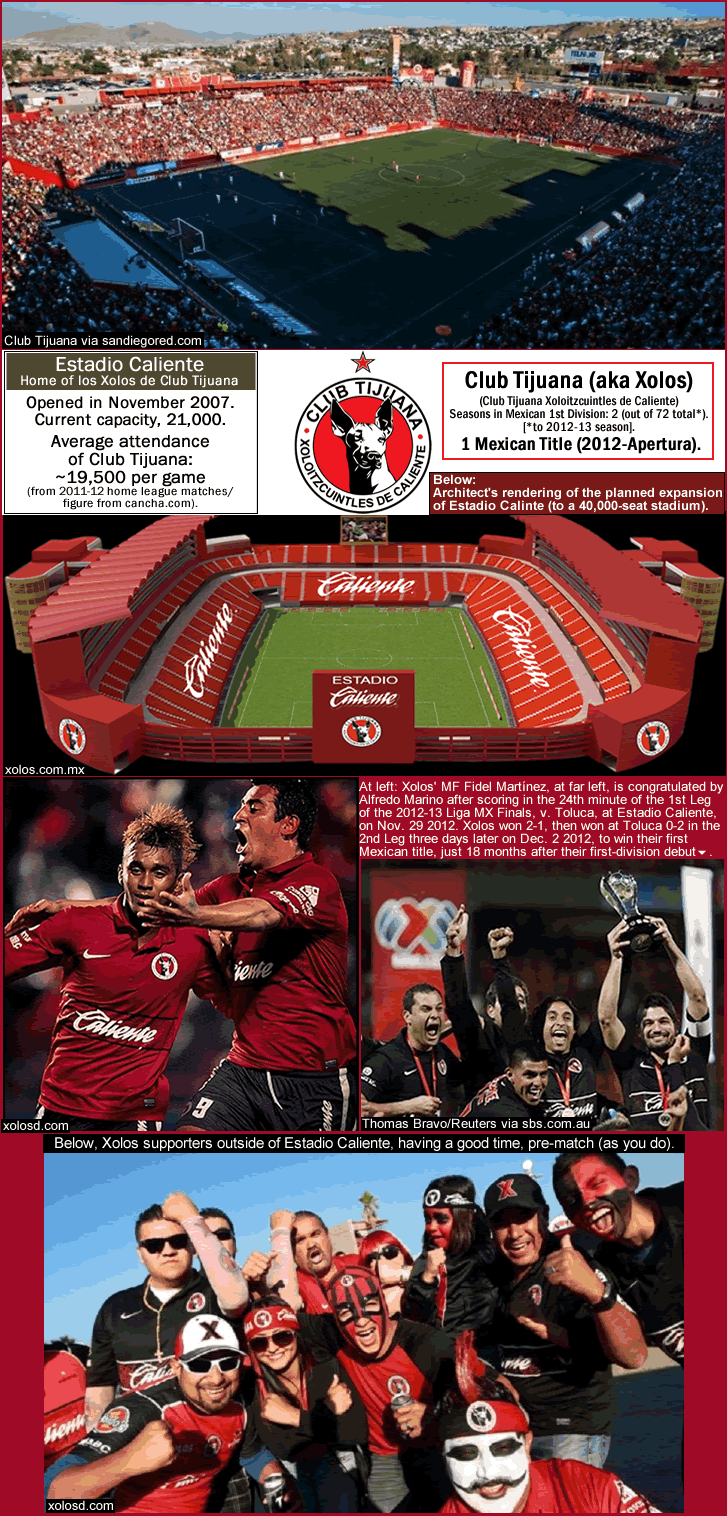
Photos and Image credits above -
Club Tijuana via sandiegored.com.
xolos.com.mx.
xolosd.com.
Tomas Bravo /Reuters via sbs.com.au.
xolosd.com.
…
The bright future of Mexican fútbol
Mexican fútbol gets pretty decent attendance – the league as a whole averaged over 26,000 per game in 2011-12. There is not nearly the amount of the fan hooliganism, safety concerns, and threats of violence like which plagues some parts of the South American football scene. Whole families go to first division fútbol games in Mexico. There are really no ultras groups who intimidate fans and players and the front office, like in Argentina. There are some nice new stadiums (like Santos Laguna’s or Club Tijuana’s or that weird one in Guadalajara [home of the Goats]). And there are some very unique stadiums, like Toluca’s stadium – see this photo by Sergiopons at panoramio.com of Estadio Nemesio Diez in Toluca), or like Pachuca’s stadium – see this post from copasdelmundoenamerica.blogspot.com. Plus, there is that singular and monumental, world-class, 105,000-capacity leviathan that is Estadio Azteca (home of the highest-drawing club in the country, Club América).
Mexico produces top shelf players like Man United’s striker Javier Hernández and FC Barcelona’s defender Jonathan dos Santos. According to one media outlet based in Germany, the Mexican top flight is currently ranked #11 in the world {see this, ‘The world’s strongest leagues in 2012: First trends‘ (iffhs.de).
One big reason why Mexico doesn’t get it’s due is that so many of their best players choose to remain in the Mexican top flight rather than seek their fame and fortune in Europe. Just check out, via the following link at en.wikipedia.org, the current roster of the ‘Mexico national football team‘ to see my point. I know the roster will change as this post gets older, but as of January 9th 2013, only 3 of the 22 players on the Selección de fútbol de México play abroad – DF Héctor Moreno (of RCD Espanyol in Spain), MF Andrés Guardado (of Valencia CF in Spain), and the aforementioned Javier Hernández (of Manchester United in England). Mexican fútbol, both as a pro venture and as embodied by it’s national team, has huge potential – Mexico won the gold medal in men’s football in the London Olympics in 2012. Mexican fútbol deserves more international attention, and I am doing my small part.
___
Thanks to RSSSf site for list of Mexican champions, http://www.rsssf.com/tablesm/mexchamp.html.
Thanks tp RSSSF site for list of Mexican seasons, ‘México – List of Final Tables‘.
Thanks to zonu.com, for Federal District (aka Mexico City) base map.
Population-density map unattributed, from ‘Metropolitan areas of Mexico‘(en.wikipedia.org [uploaded by Rune.welsh].
Base map by Sémhur at commons.wikimedia.org, File:Mexico States blank map.svg.
Thanks to Tom Marshall for the 2 articles I featured here (from Goal.com at the top of the post, here again [A New year's Liga MX wishlist; and at soccer365.com, here again [attendances]. – here is Tom Marshall’s Twitter page – https://twitter.com/mexicoworldcup .
Thanks to David at XoloSD.com ( XoloSD.com ), for information on Liga MX.
